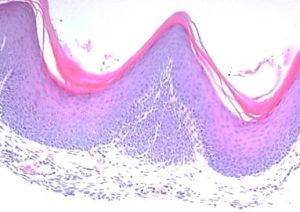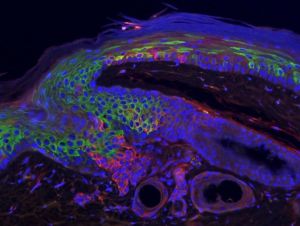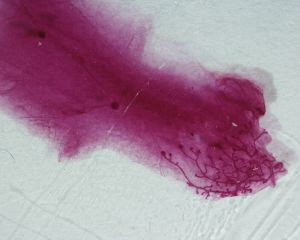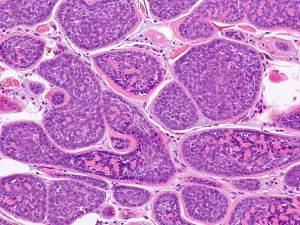
Lung Cancer
The development of new animal models of lung cancer is essential for the understanding and treatment of this disease in humans.
Lung cancer is the leading cause of cancer mortality (18.2 % of all deaths in 2008). In addition it is the cancer with the highest incidence and the most frequently diagnosed worldwide (12.7 % of all diagnosed cases), with a high level of deaths, poor prognosis and low survival (with a mortality/incidence rate of 0.86) .
Genetically modified animal models provide tools for preclinical use appropriate for monitoring and detection of early lesions and/or therapeutic remission and to test new therapeutic and chemopreventive agents, which otherwise could not be evaluated.
In the Molecular Oncology Unit we relay on adenoviral cre expression systems that allow for the deactivation of key genes for the development of tumor pathology. These virus are inoculated into the lung by intranasal instillation and intratracheal intubation. In this way we generate models of lung cancer which genetically and histopathologically are very similar to humans and allow us to study multiple aspects of the biology of this tumor type, testing new potential drug molecules and therapeutic responses.
These models are also used for the development of advanced molecular imaging techniques in vivo, in close collaboration with the Unit of Biomedical Applications and Pharmacokinetics.
Genitourinary Cancer
In the field of Genitourinary Cancer, the activities of the Molecular Oncology Unit are centered in three main areas:
Renal Cell Carcinoma: Around 200000 new cases of kidney cancer are diagnosed worldwide each year, accounting for 2% of all cancers. Renal cell carcinoma (RCC) is the most common type of kidney cancer in adults, responsible for approximately 80% of all cases. RCC represents diverse types of tumors, possibly with different cell origin and possessing distinct genetic characteristics, histological features, and, to some extent, clinical outcomes. The treatment options for RCC are surgery, radiation therapy, chemotherapy, hormonal therapy, immunotherapy, or combinations of these. The treatment of RCC has been transformed over recent years with introduction of molecularly targeted therapies, in particular those against VEGF and mTOR. Besides obtaining a deeper knowledge on the molecular basis of RCC, one of our main aims is to identify genetic factors that may predict the patient response to these targeted therapies.
Prostate cancer: It is the most common cancer in men and the sixth leading cause of cancer death in males worldwide. While most prostate cancers are slow growing, there are cases of aggressive prostate cancers with metastatic spreading from the prostate to other parts of the body, particularly the bones and lymph nodes. Prostate cancer, especially low-grade forms found in the elderly, often grows so slowly that no treatment is required. However, in aggressive forms the treatment may involve surgery, radiation therapy, chemotherapy, hormonal therapy, or some combination of these. In general, hormonal therapy (affecting androgen-dependent signaling) is providing good outcomes. However, the hormone dependent cancers become refractory after one to three years and resume growth despite hormone therapy. Mutations in multiple genes have been associated with prostate cancer development. Among them those affecting the ETS family of transcription factors are of particular relevance. The Molecular Oncology Unit activities in this particular tumor type are:
- Develop new genetically engineered mouse models that recapitulate different types of human disease.
- Identify the molecular basis of hormone resistance and characterize new biomarkers of diagnostic and predictive value.
- Characterize the specific roles of different ETS TF family and their translocation products.
Bladder cancer: The most common type of bladder cancer is known as urothelial cell carcinoma. It is the 5th most commonly diagnosed cancer in men and the ninth in women worlwide. Two main tumor types of BC are characterized at diagnose, the muscle infiltrating (MIBCs) and the non-muscle infiltrating (NMIBC). Recent studies have suggested that these different pathological entities also reflect different molecular features. The NMIBC are usually treated by transurethral resection, in some cases followed by instillations. However, recurrence of the NMBIC is very high, and in some cases tumor progression to MIBC occurs. Remarkably, there is no improvement of BC therapy in the clinic for more than 20 years and no molecularly targeted therapies are currently being used. The Molecular Oncology Unit activities in this particular tumor type are:
- Develop new genetically engineered mouse models to model NMBIC and MIBC (in particular metastatic types) of preclinical use.
- Identify possible biomarkers of diagnostic and predictive value for NMBIC.
- Characterize the molecular mechanisms leading to MIBC in order to identify possible targets for specific therapies.
Head and Neck Squamous Cell Carcinoma

Head and neck squamous cell carcinoma (HNSCC) comprises epithelial tumours of the oral cavity, pharynx, larynx, and nasal cavity. Its main risk factors are smoking, alcohol consumption and human papillomavirus infection. HNSCC is the sixth most common cancer worldwide and despite recent advances in the therapeutics overall survival is still low, around 50. Also, there is a high risk of tumour relapse and development of metastasis that hampers successful therapy.
In the Molecular Oncology Unit we use high throughput technology to identify genetic alterations and gene expression profiles characteristic of tumours. These approaches are changing the way we understand, diagnose and treat cancer, and are setting the bases for so-called personalised medicine. Comparative genomic analyses of transgenic animal models with alterations in molecular pathways involved in oral cancer, developed in our laboratory, that reproduce the features of HNSCC and human samples, will allow us to validate these models at the molecular level in order to use them for drug testing and to unravel the molecular mechanisms underlying this pathology. We are also working in the identification of alterations in genes that are key to the development of this kind of tumour in humans. This dual approach will lead to the identification of driver genes and driver pathways responsible for the different tumour types making possible the development and use of patient specific therapies.
Another topic of research within our group, carried out in collaboration with the National Institute of Dental and Craniofacial Research in Bethesda and the Instituto de Investigación Hospital 12 de Octubre in Madrid, is the identification of drugs with antitumoural activity targeted to specific molecules or molecular pathways suitable for the treatment of HNSCC. The only approved therapy of this kind is an antibody specific for the epidermal growth factor receptor (EGFR) that is frequently amplified in these tumours. Besides alterations in EGFR, other molecular pathways involved in HNSCC development include PI3K/Akt/mTOR pathway, and p53 that is mutated in 60-80% of cases. We are using xenograft models of cell-derived human tumours bearing genetic alterations in these pathways implanted in immunodeficient mice to evaluate the efficacy of molecularly targeted therapies for HNSCC treatment. These studies are an essential step in preclinical drug evaluation and our aim is to use the successful compounds in clinical trials.
Nonmelanoma Skin Cancer

The skin is the organ that presents the largest number of diseases, including skin cancer. Non-melanoma skin cancers (NMSC): basal cell carcinomas (BCC) and squamous cell carcinomas (SCC) are the most common human malignancies; in addition SCCs are characterized by an important risk of metastasis. The incidence of both benign and malignant skin neoplasms has been rising at an alarming rate for the past several years. Besides ultraviolet light, other hazard factors have been associated with nonmelanoma skin cancer, such as tobacco smoke and human papilloma virus infection.
Our group studies the molecular mechanisms responsible for the development and progression of these two most common types of cancer. Our previous results suggest that the proteins of the NF-kB signaling pathway are responsible for the emergence of both BCCs and SCCs, therefore, the specific Molecular Oncology Unit activities in this particular tumor type are:
- Characterize the specific roles of different NF-kB components (mainly IKK1 and IKK2) in the genesis and progression of BCCs and SCCs in order to identify possible targets for specific therapies.
- Develop new genetically engineered mouse models that recapitulate both BCCs and SCCs for preclinical use.
- Identify new biomarkers of diagnostic and predictive value for this frequent cancer type.
- Study of the potential use of other molecules related to the NF-kB signaling as tumor suppressors of nonmelanoma skin cancer.
Breast Cancer
 Breast cancer is a disease (or rather a group of diseases) of huge prevalence. Only in Spain more than 20,000 new cases are diagnosed annually. Moreover, breast cancer is the most deadly type of cancer among women, causing over 400,000 deaths each year worldwide. These conditions imply, therefore, a health problem of the first magnitude, with a huge personal cost both for patients and relatives, an also an inmense economical burden for the National Health System . Although the involvement of certain genes (such as BRCA1, BRCA2, TP53) in the development of breast cancer is known, the etiology of most breast tumors is unknown at this time, which hinders the application of efficient therapies. In recent times there has been tremendous progress in understanding the genetic basis of these diseases , mainly thanks to the application of genomic technologies for high performance, but we are still far from a complete understanding of these process. Large scale studies on hundreds or thousands of breast tumors have shown that these tumors are genetically very complex, and in each tumor there are hundreds or thousands of mutations. An urgent need is to know which of these mutated genes is responsible for tumor development (driver mutations causing tumors) as opposed to the many mutated genes as a result of faulty cellular processes in tumor cells (passenger mutations). This knowledge is of practical importance because it could focus therapeutic efforts on the few major "driver" genes, disregarding the rest. One of the worklines in our laboratory is to find genes whose mutation is able to cause the development of breast tumors. To achieve this goal, we employ active transposons as mutagens in model systems (transgenic mice and human breast cells) and high-throughput genomic analysis.
Breast cancer is a disease (or rather a group of diseases) of huge prevalence. Only in Spain more than 20,000 new cases are diagnosed annually. Moreover, breast cancer is the most deadly type of cancer among women, causing over 400,000 deaths each year worldwide. These conditions imply, therefore, a health problem of the first magnitude, with a huge personal cost both for patients and relatives, an also an inmense economical burden for the National Health System . Although the involvement of certain genes (such as BRCA1, BRCA2, TP53) in the development of breast cancer is known, the etiology of most breast tumors is unknown at this time, which hinders the application of efficient therapies. In recent times there has been tremendous progress in understanding the genetic basis of these diseases , mainly thanks to the application of genomic technologies for high performance, but we are still far from a complete understanding of these process. Large scale studies on hundreds or thousands of breast tumors have shown that these tumors are genetically very complex, and in each tumor there are hundreds or thousands of mutations. An urgent need is to know which of these mutated genes is responsible for tumor development (driver mutations causing tumors) as opposed to the many mutated genes as a result of faulty cellular processes in tumor cells (passenger mutations). This knowledge is of practical importance because it could focus therapeutic efforts on the few major "driver" genes, disregarding the rest. One of the worklines in our laboratory is to find genes whose mutation is able to cause the development of breast tumors. To achieve this goal, we employ active transposons as mutagens in model systems (transgenic mice and human breast cells) and high-throughput genomic analysis.
Rare Diseases Related to Cancer

Rare diseases are those that affect a limited number of individuals with regard to the general population, less than one of every 2,000. It is estimated the existence of 8,000- 12,000 different rare diseases, affecting between 6% and 8% of the total population.
The skin is the organ that presents the largest number of diseases. Many of them are considered rare diseases. In the Molecular Oncology Unit we study cutaneous hereditary rare diseases associated with the development of skin tumours. This is the case of hereditary cylindromatosis , family trichoepitheliomas and Brooke- Spiegler syndrome . These diseases are caused by mutations in the CYLD gene. CYLD is a tumor suppressor primarily known for its function as an inhibitor of the NF-kB signaling pathway activation. However, although all these diseases have in common the constitutive activation of NF- kB, clinical data show that there must be other molecular alterations relevant for the development of these pathologies. Currently, surgery is the only way to treat these conditions, but this is a symptomatic, not curative treatment, so patients still develop tumors throughout his life, requiring in many cases of skin grafts.
In our Unit we have generated preclinical models of transgenic mice deficient in the catalytic function of CYLD. These approaches are aimed to discover the molecular basis by which inactivation of CYLD causes hereditary cylindromatosis , family trichoepitheliomas and Brooke- Spiegler syndrome. The ultimate goal is to search for specific molecules for the treatment of these incurable rare skin tumor diseases.
